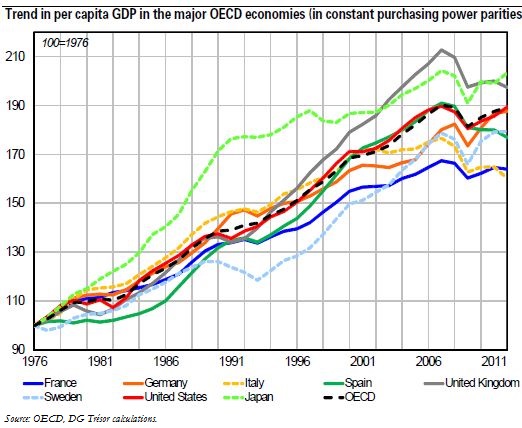Trésor-Economics No. 131 - How to account for the drop-off in France's per capita GDP in the last 40 years?
Between 1975 and 2012, France's per capita GDP rose more slowly than the average for OECD countries, particularly as compared to the United States and, to a lesser extent Germany and Northern Europe. France ranked above the OECD average in 1975, but as a result of this slower growth, now ranks lower than most of the major developed economies except Italy and Spain.
The underlying factors in France's relative decline can be identified through a growth accounting approach to the various components of per capita GDP: working-age population, labour force participation rate, unemployment rate and per capita productivity.
In terms of working-age population, France's demographics over the period temporarily penalise its per capita GDP performance compared to other countries. However, demographics are expected to become a positive factor in the future, when today's under-15 population reaches working age. In terms of the labour force participation rate particularly among youth and older workers, France lags even farther behind most comparable OECD economies for the entire period. This is especially true with respect to Germany and the Northern European countries, which France also trails in terms of the labour participation rate among women. As for unemployment, the French unemployment rate has exceeded the average unemployment rate of the OECD economies since the mid-1980s.
When it comes to productivity, the trend is milder. Through the early 1990s, France was increasing its lead in terms of per capita productivity on the strength of its high hourly productivity. Since the 1990s, however, the relative stagnation of France's hourly productivity coupled with the steady decline in the number of per capita hours worked have had a negative effect. As a result, the other OECD economies (particularly the United Kingdom and the Northern European countries) have caught up in terms of per capita productivity and the United States has widened its lead.
All in all, per capita GDP growth in France in the past 40 years has lagged an average of 0.4 points behind that of the OECD countries with demographics subtracting 0.1 points and the employment rate (labour force participation and unemployment rates) subtracting 0.2 points. For the period as a whole, per capita productivity has had no adverse effect on the growth deficit. However, since the mid-1990s, French hourly productivity gains have no longer been sufficient to offset the decline in the number of hours worked. The lower per capita productivity accounts for the bulk of the growth deficit relative to the OECD average over the past twenty years (0.5 points).
This analysis highlights the various objectives that France must pursue in order to raise its per capita GDP. These match the priorities defined in the country's national reform programme: increase the labour force participation rate, especially among older workers; curb structural unemployment; support gains in hourly productivity (e.g. through innovation, competitiveness, flexicurity, vocational training).
